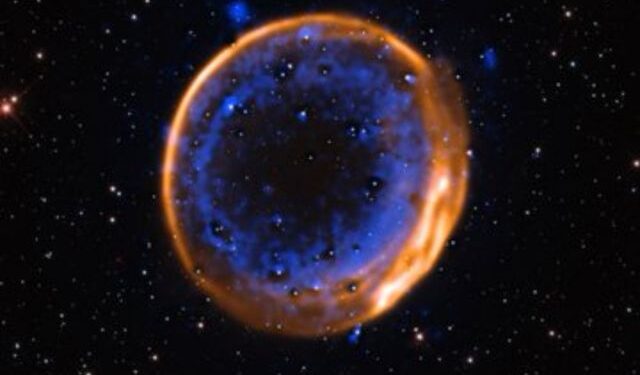In a groundbreaking cosmic revelation, astronomers have captured the first visual evidence of a dying star erupting in a rare double detonation, confirming a long-suspected theory about the demise of certain white dwarfs.
The event was recorded using the European Southern Observatory’s (ESO) Very Large Telescope, which closely observed the supernova remnant SNR 0509-67.5. This remnant, located about 160,000 light-years away in the Large Magellanic Cloud—a galaxy adjacent to the Milky Way—has long been suspected of hosting an unusual stellar endgame.
The star in question, a white dwarf roughly the size of our Sun, succumbed to two back-to-back explosions. The phenomenon, referred to as a double detonation, occurs when a surface helium layer ignites first, triggering a second, far more destructive explosion in the star’s core.
“This tangible evidence of a double detonation not only contributes to solving a long-standing mystery, but also offers a visual spectacle,” said Priyam Das, lead author and PhD student at the University of New South Wales Canberra.
In contrast to traditional Type Ia supernovae, which often leave behind dense neutron stars or black holes, the double detonation obliterated the white dwarf entirely, leaving behind a beautifully layered calcium-rich remnant. The time between the two detonations? Just two seconds.
This stunning visual confirmation—recently published in Nature Astronomy—is poised to reshape our understanding of cosmic evolution, stellar physics, and the very mechanisms behind the universe’s most energetic events.
















 >> Ready for Raja Saab chills? 😍""Ravishing Malvika x Epic Prabhas = January blockbuster! 🌟""Beach slay to Raja throne. Malvika's month is lit! 🔥#MalvikaMohanan
#RajaSaab
#TheRajaSaab
#Prabhas' data-src='https://scontent-bom5-1.cdninstagram.com/v/t51.71878-15/607277750_25235957859410048_4986893047092392714_n.jpg?stp=dst-jpg_e35_tt6&_nc_cat=109&ccb=7-5&_nc_sid=18de74&efg=eyJlZmdfdGFnIjoiQ0xJUFMuYmVzdF9pbWFnZV91cmxnZW4uQzMifQ%3D%3D&_nc_ohc=4P4NgveXrCQQ7kNvwFXYUr_&_nc_oc=AdmB4frSH8UoDUxLFx2jeFEPMR0XBvtBMzFIbVDSbZCG8i4E-XwNnviIUm2Dy70vs-fcuWh-OOS8aA-3k58j6eZ1&_nc_zt=23&_nc_ht=scontent-bom5-1.cdninstagram.com&edm=ANo9K5cEAAAA&_nc_gid=KbBsh3HdPQxxhVFJpXvS2Q&oh=00_Afr58NJbqdAzeaZ7duC7AKD3K3KhXPWXumxyvXkCf0pxMw&oe=696529E2' title='"Waves crashing, Malvika slaying. Ravishing looks from her rocky shoot, countdown on for Prabhas-Malvika madness in Raja Saab! 🎥⚡"Reel Hooks"Malvika's rocky beach glow >>> Ready for Raja Saab chills? 😍""Ravishing Malvika x Epic Prabhas = January blockbuster! 🌟""Beach slay to Raja throne. Malvika's month is lit! 🔥#MalvikaMohanan
#RajaSaab
#TheRajaSaab
#Prabhas'>
>> Ready for Raja Saab chills? 😍""Ravishing Malvika x Epic Prabhas = January blockbuster! 🌟""Beach slay to Raja throne. Malvika's month is lit! 🔥#MalvikaMohanan
#RajaSaab
#TheRajaSaab
#Prabhas' data-src='https://scontent-bom5-1.cdninstagram.com/v/t51.71878-15/607277750_25235957859410048_4986893047092392714_n.jpg?stp=dst-jpg_e35_tt6&_nc_cat=109&ccb=7-5&_nc_sid=18de74&efg=eyJlZmdfdGFnIjoiQ0xJUFMuYmVzdF9pbWFnZV91cmxnZW4uQzMifQ%3D%3D&_nc_ohc=4P4NgveXrCQQ7kNvwFXYUr_&_nc_oc=AdmB4frSH8UoDUxLFx2jeFEPMR0XBvtBMzFIbVDSbZCG8i4E-XwNnviIUm2Dy70vs-fcuWh-OOS8aA-3k58j6eZ1&_nc_zt=23&_nc_ht=scontent-bom5-1.cdninstagram.com&edm=ANo9K5cEAAAA&_nc_gid=KbBsh3HdPQxxhVFJpXvS2Q&oh=00_Afr58NJbqdAzeaZ7duC7AKD3K3KhXPWXumxyvXkCf0pxMw&oe=696529E2' title='"Waves crashing, Malvika slaying. Ravishing looks from her rocky shoot, countdown on for Prabhas-Malvika madness in Raja Saab! 🎥⚡"Reel Hooks"Malvika's rocky beach glow >>> Ready for Raja Saab chills? 😍""Ravishing Malvika x Epic Prabhas = January blockbuster! 🌟""Beach slay to Raja throne. Malvika's month is lit! 🔥#MalvikaMohanan
#RajaSaab
#TheRajaSaab
#Prabhas'>











